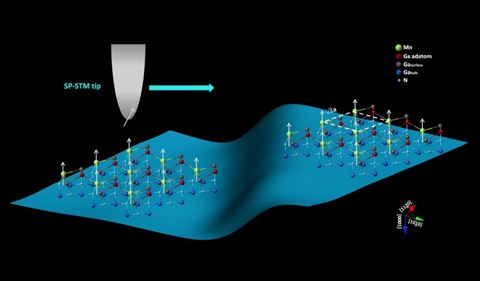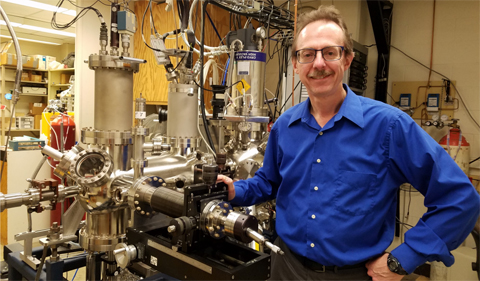
A visual representation of SP-STM measurements to characterize ferromagnetism in 2D-MnGaN (Image courtesy of Arthur R. Smith)
By Amanda Biederman
NQPI editorial intern
Nanoscale and Quantum Phenomena Institute 2019 Spring Newsletter
Seen on almost all household refrigerator doors, magnets are commonplace items. Yet scientists are still working to fully understand how magnetic structures form, especially at the atomic level. Magnetism, or the phenomenon that creates attraction or repulsion between particles based on their spin orientations, can be produced in a variety of materials. Yet typical household magnets display only one version of this intriguing natural wonder, ferromagnetism, which represents a perfect magnetic collective alignment of all spins. Ferromagnetism is well characterized in three-dimensional objects (imagine a cube, for example) but is often difficult to produce at reduced dimensions. In a paper published in Nano Lett. 2018, 18, 158–166, Physics professor & NQPI member Arthur R. Smith and co-workers reported the discovery of ferromagnetism in a two-dimensional material (akin to an isolated cube face) at room temperature.
“We’re really looking at the ultimate limit of thin-film ferromagnetism,” Smith said. “This isn’t the first time people have seen ferromagnetism in atomically thin structures, but in the past they’ve seen it only at very low temperatures … and in terms of any possible future applications, this is much more applicable.”

Arthur R. Smith poses in front of his group’s spin- polarized scanning tunneling microscope.
Smith, along with former doctoral physics students Yingqiao Ma and Abhijit Chinchore, synthesized 2-dimensional (2D) manganese gallium nitride on top of a layer of semiconductive gallium nitride. They characterized the 2D-MnGaN’s electronic and magnetic properties using spin-polarized scanning tunneling microscopy (SP-STM). Previously, the group had demonstrated that manganese, gallium, and nitrogen atoms (on the surface of gallium nitride) order in a unique configuration.
“In essence, it forms a quasi-hexagonal structure,” Smith said. “Imagine a 2D layer of atoms in a distorted hexagonal network. Each nitrogen-bonded, magnetic manganese atom is indirectly coupled to six manganese neighbors through an intervening network of gallium atoms.”
Using this system, the groups characterized the topographical structure of the material. In addition, they generated images of magnetic arrangements. Their results demonstrated a uniform orientation of spin direction across the sample at room temperature, evidence of ferromagnetism. These findings were supported with theoretical calculations by their collaborators, University of Buenos Aires professor María Andrea Barral and Valeria Ferrari, a professor at the National University of San Martín, co-authors on the paper.
Currently, Smith’s group is completing follow-up research on this system. Collaborating with Ohio State University Physics professor Fengyuan Yang, they are employing a technique called superconducting quantum interference device (SQUID) magnetometry to generate quantitative measurements of ferromagnetism in their samples. In addition, the group is pursuing other experiments in which the manganese gallium nitride structure is manipulated to produce different magnetic effects.



















Comments